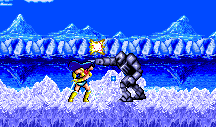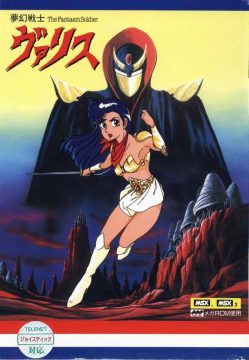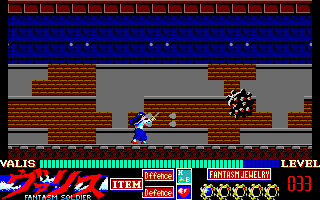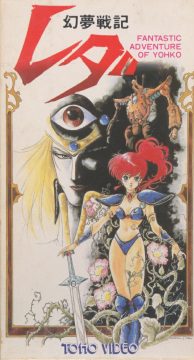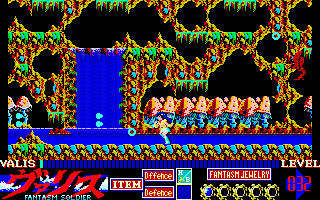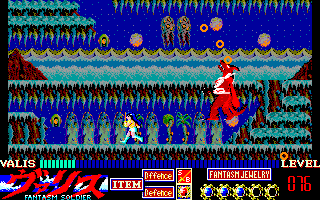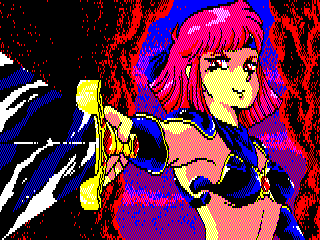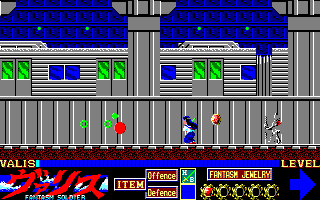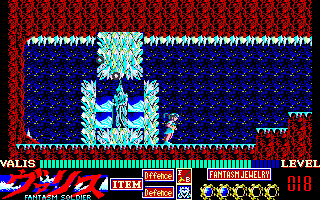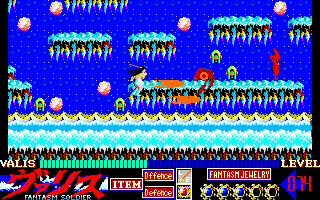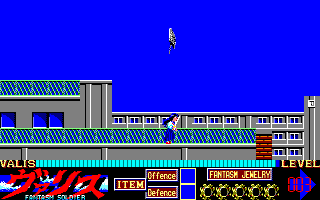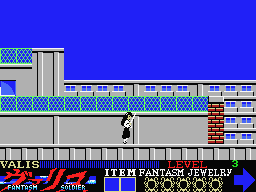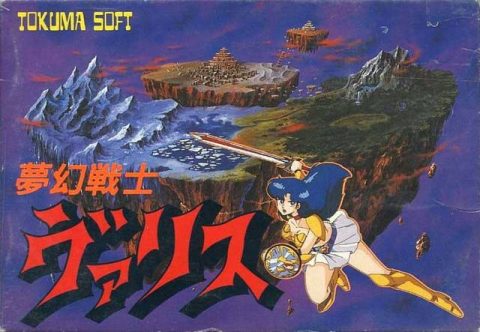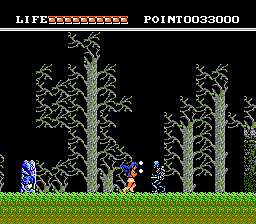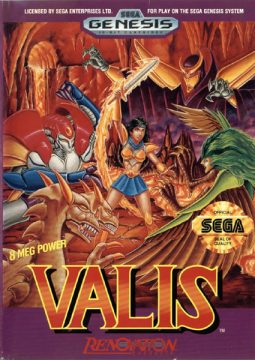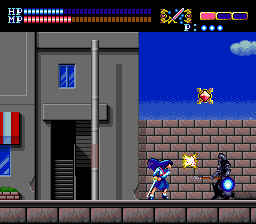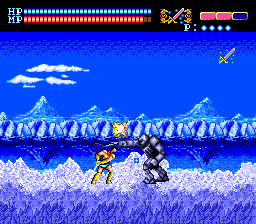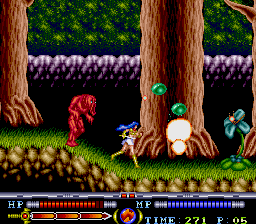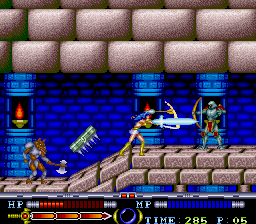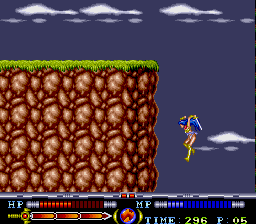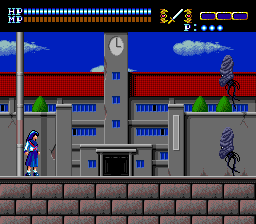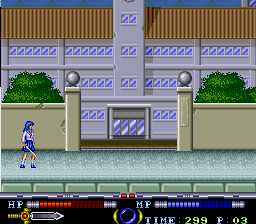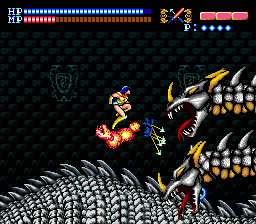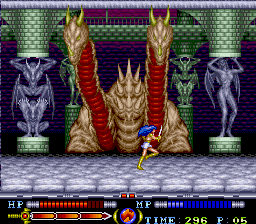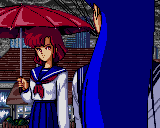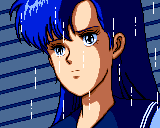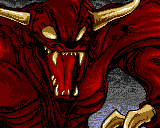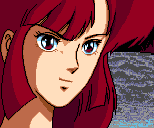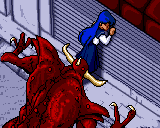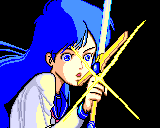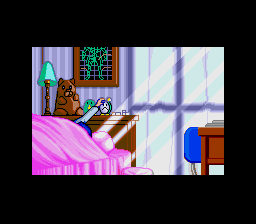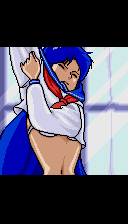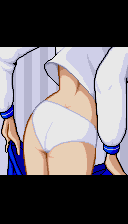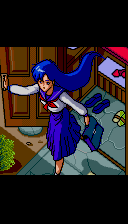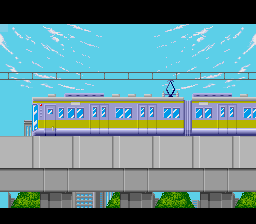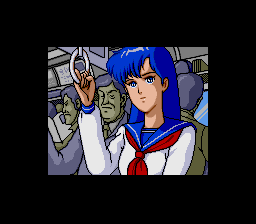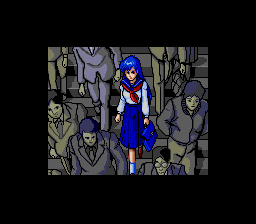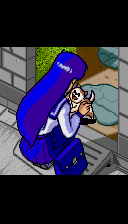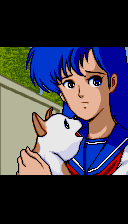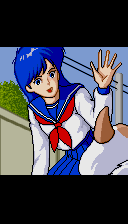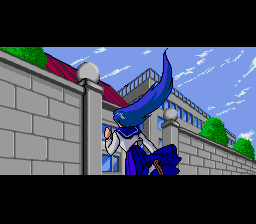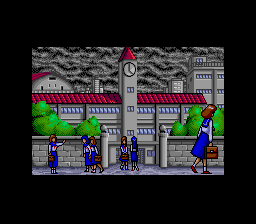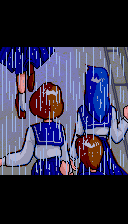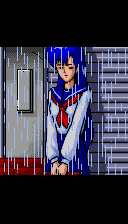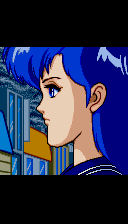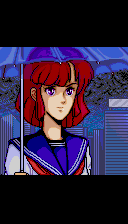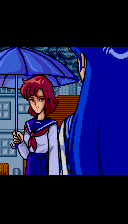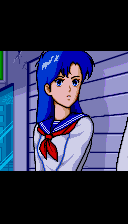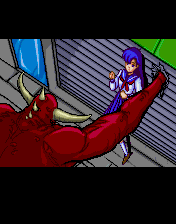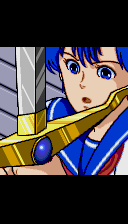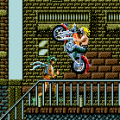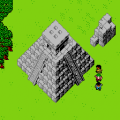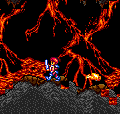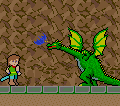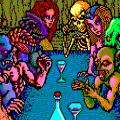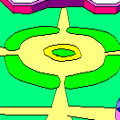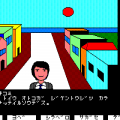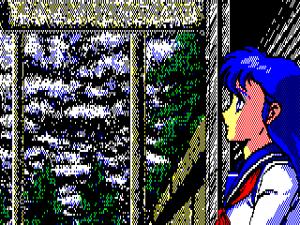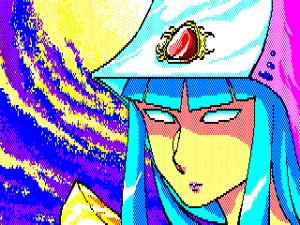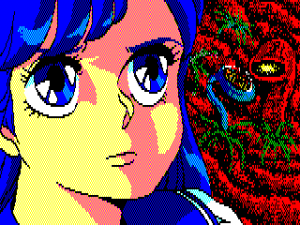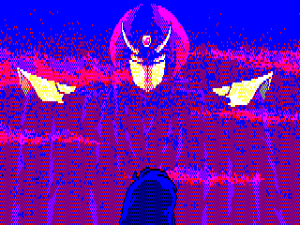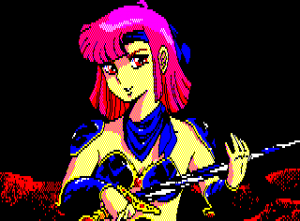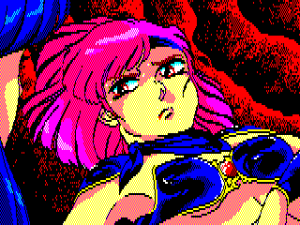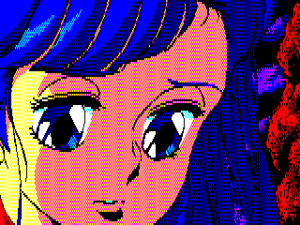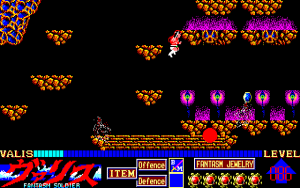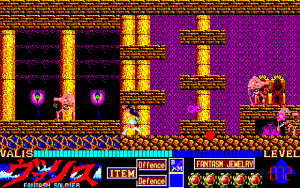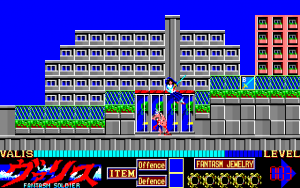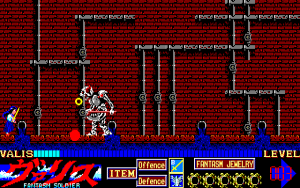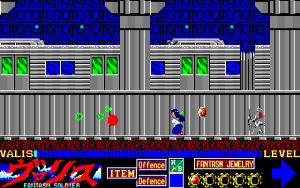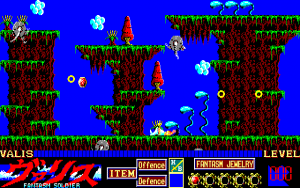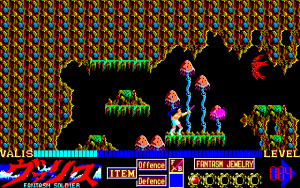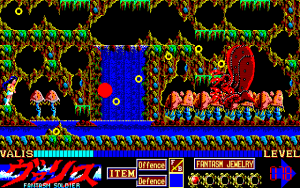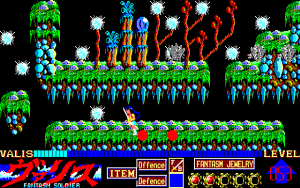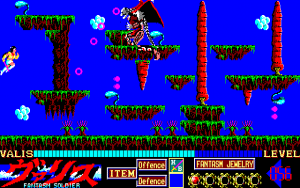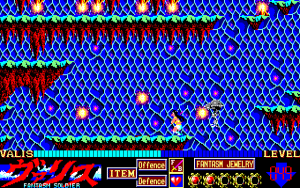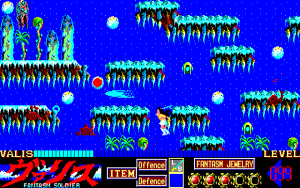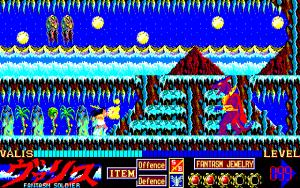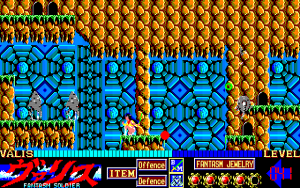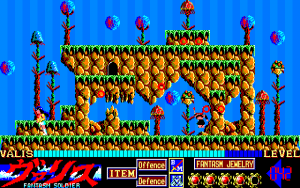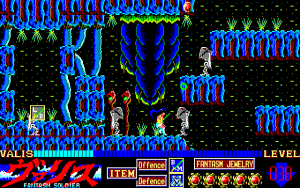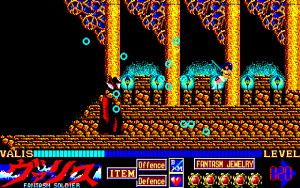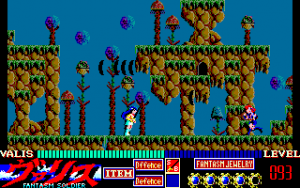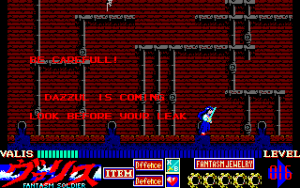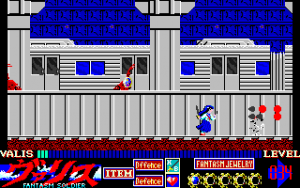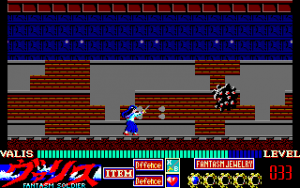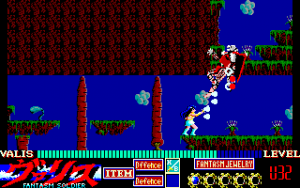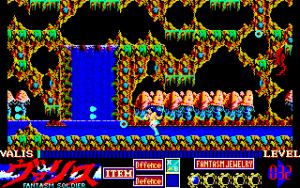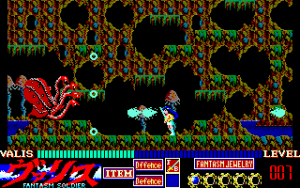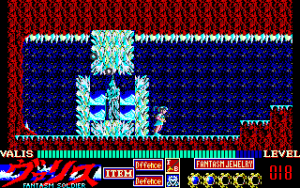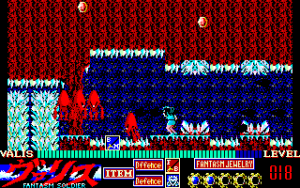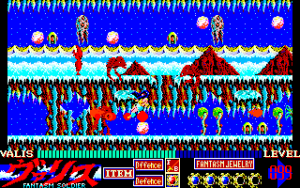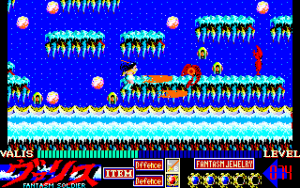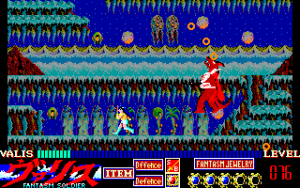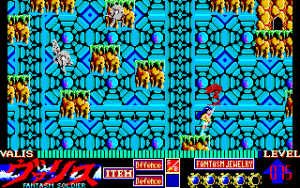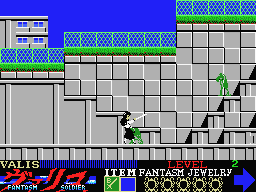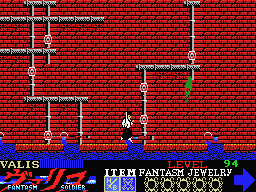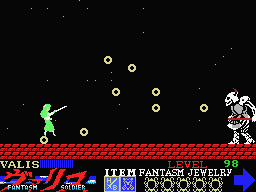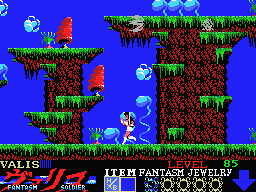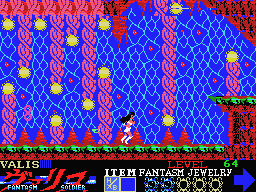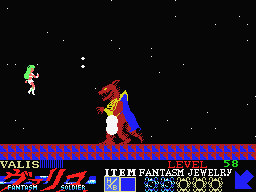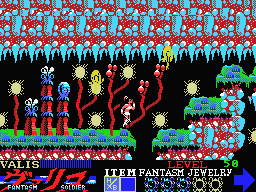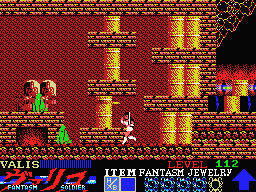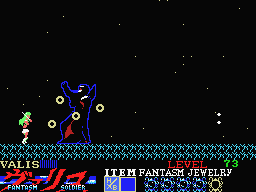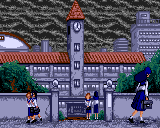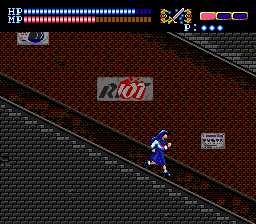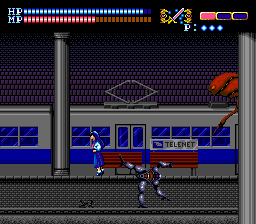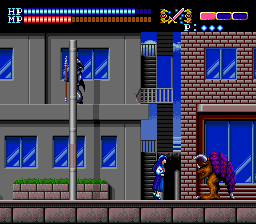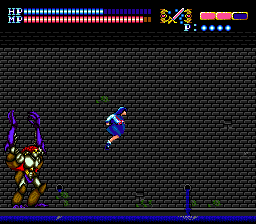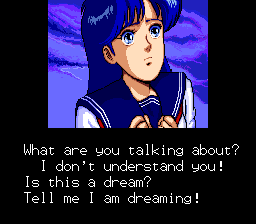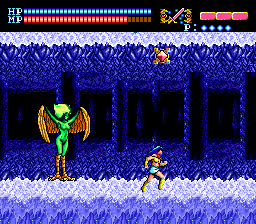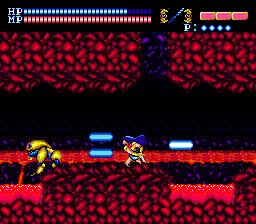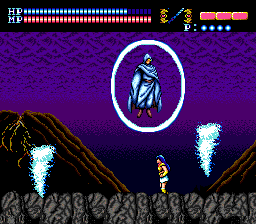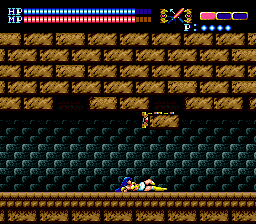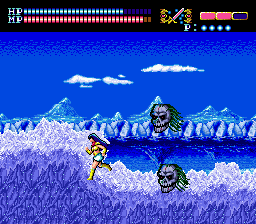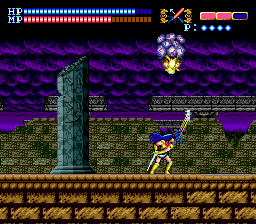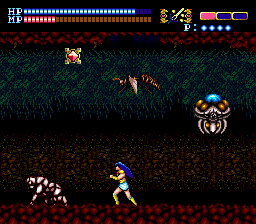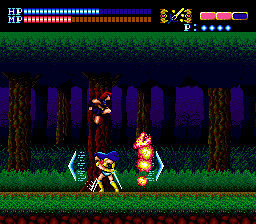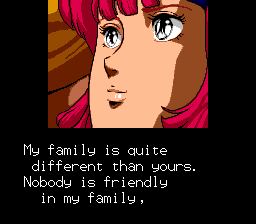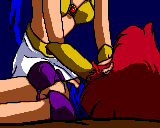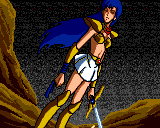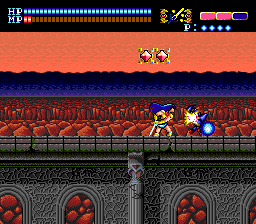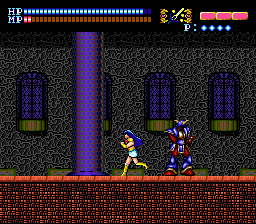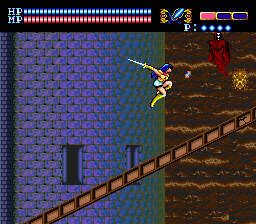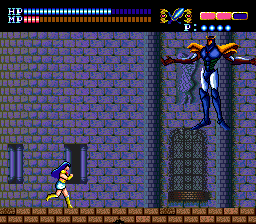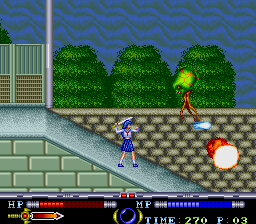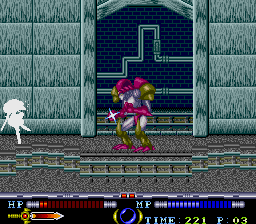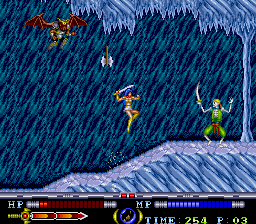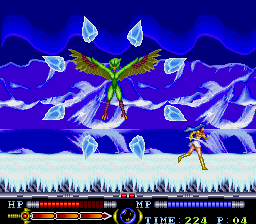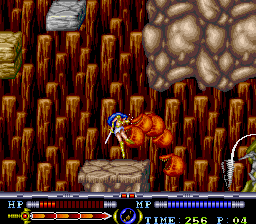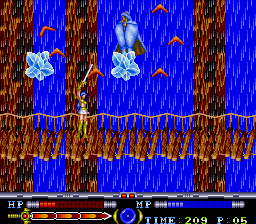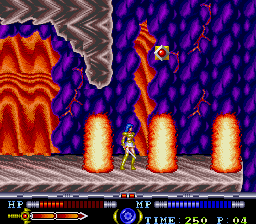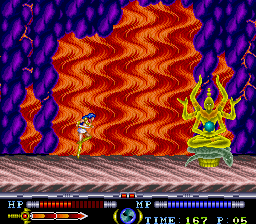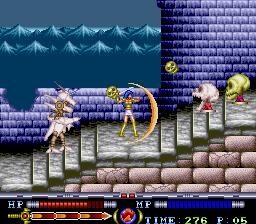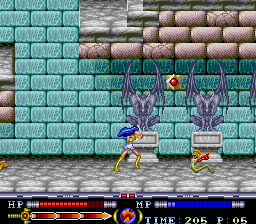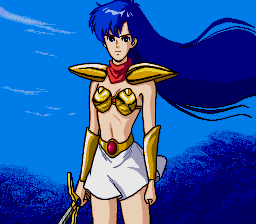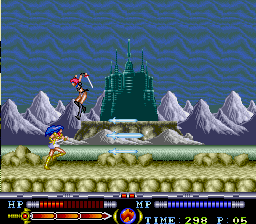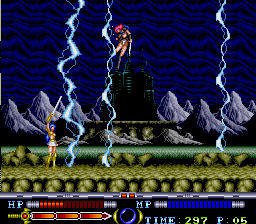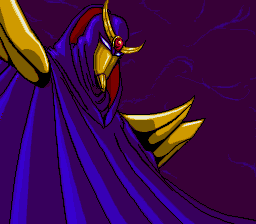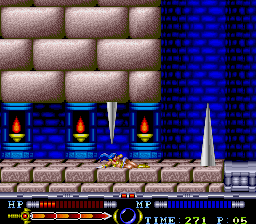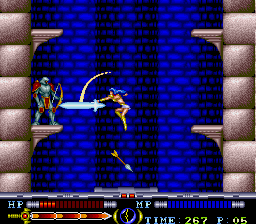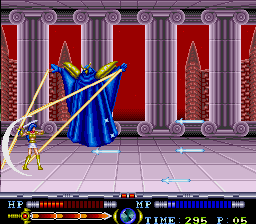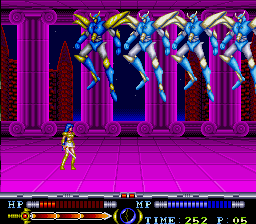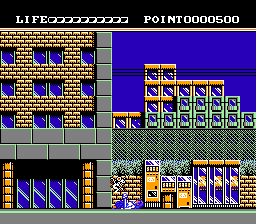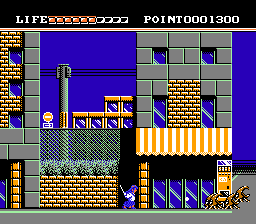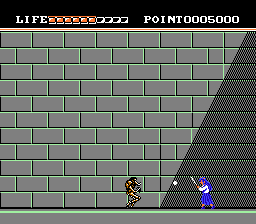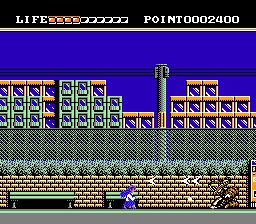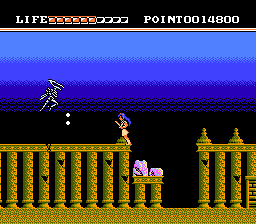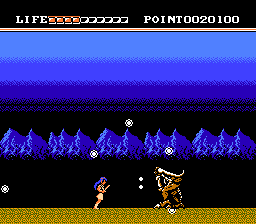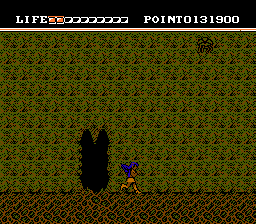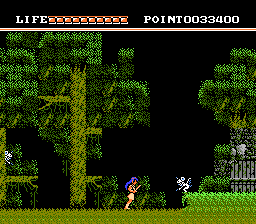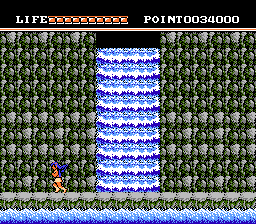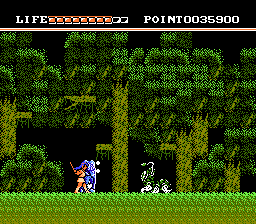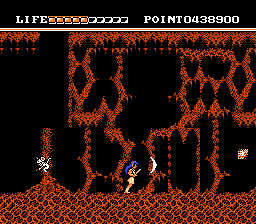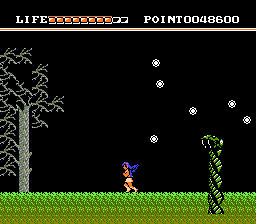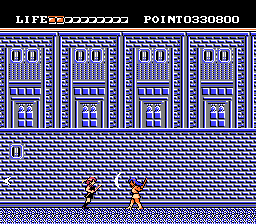Valis used to be the pride of Japanese B-tier developer Telenet. Due to the games being decent at best, the series was never very well-regarded in the West, but the anime girl appeal seems to have secured it some popularity in its home country. Since 1985, there had been a boom of female protagonists in Japanese games, but Valis was the first to adapt the popular “magical school girl” anime genre, which in the English speaking world is best known through Sailor Moon.
The heroine of Valis is Yuko Aso, a seemingly ordinary girl at a Japanese high school – until monsters start invading her town and the Valis Sword is bestowed upon her. The sword brings her to the magical dream world Vecanti, where she is greeted by the queen Valia, who turns her into the Valis Soldier and urges her to defeat the evil Rogles, who has invaded Vecanti. But Yuko is not the only one who has been called into the dream world: Her friend Reiko is under Rogles’ spell and tries to hinder her progress.
Valis itself was almost certainly inspired by the 1985 anime OVA Reda: The Fantastic Adventure of Yohko, which has an almost identical setup, right down to the heroine in the bikini armor.
The original Mugen Senshi Valis, released for a number of Japanese home computers, was created by the famed Wolf Team, and just like their other early game, Final Zone, it’s pretty bad. Basically, it’s a side-scrolling action game like Ghosts’n Goblins or Castlevania, but much like many of the infamous Euro platformers later, it features vast multiscrolling mazes in place of the short, tightly designed stages of its Japanese contemporaries. There’s always an arrow on screen to point the player in the right direction, but following it too closely means missing out on most of the power-ups. But even just the direct path to the boss is ridiculously long, and there’s nothing interesting in between. The same portions are literally copied and pasted next to each other dozens of times, so without the helpful arrow Yuko would be hopelessly lost.
Still the game wouldn’t be quite as insufferable if the controls weren’t as inept as they are. Yuko has a weird double-tiered jump, where she gets another boost in mid-air when the button is held down (and this being a computer game, the button for jump of course is “up”), yet they’re Castlevania style “stiff” jumps, where the direction and trajectory is strictly fixed. The problem is, her extended jump is so long it’s almost impossible to guess beforehand where she’ll land exactly. And that’s before she gets hit by an enemy in mid-air and is pushed back in the opposite direction. So far that’s period-appropriate, but on top of that there is no recovery time after a hit, so usually Yuko gets flailed around helplessly multiple times, before she can land on her feet again, more often than not even further back then where she started out. And since the stages are mostly copy & paste, when Yuko falls down a screen in a climbing segment, she usually keeps falling for quite a long stretch.
Most players’ first impulse would be to clear a screen of enemies before attempting any risky jumps, but that’s no use here: The monsters keep respawning endlessly, no matter whether Yuko is running around or standing still. They attack relentlessly, and there’s not a second to relax. Most attackers come from above, and thanks to the choppy gameplay, fighting off flying enemies reliably is simply not possible.
Every once in a while, Yuko happens upon powerups that improve her armor or upgrade her sword with different types of projectiles, which is an absolute necessity, as trying to hit enemies with the basic sword strike only ever ends in tears. But nothing comes for free in Vecanti – each upgrade consumes several bars of health when picked up. The more powerful the weapon, the more it damages Yuko first. If she actually doesn’t have as much health as the item costs, she is scolded with the message “Ill gotten goods never prosper!”, and suddenly the flying enemies start an insane bombardment of bullets that kill her within seconds. Yuko’s only saving grace is her ability to charge up her health bar a hundred times by picking up capsules left behind by defeated enemies. That’s right Wolf Team managed to introduce grinding to an action game. Really the only way to get through most of the bosses is to find a spot where mostly ground-based enemies attack and to grind up a few dozen health bars before jumping into the boss’ screen-filling streams of bullets and try to defeat them in a war of attrition. Most vital is a healthy pocket of charged bars before entering stage 3, because that only has flying enemies, which invariably means that Yuko will end it with much less health than she started with.
Mugen Senshi Valis might be a horrible, unplayable mess, but its call to fame to begin with wasn’t the gameplay, but the pioneering in cinematic cutscenes – two years even before Ninja Gaiden. That achievement has to be put in perspective, though, as the cutscenes consist almost entirely of close-ups of anime heads, with very few exceptions. There are a few instances of scrolling along a character’s full body view, but the sole bit of action is the scene where Reiko draws her sword and points it toward her friend/rival, before they have their duel to the death. What’s left is the quite excellent chiptune music, really the only part the original Valis is worth being remembered for. Fortunately the PC-88 and FM-7 versions contain a music jukebox (accessed by pressing F5 on the title screen), so no one actually has to play the game to enjoy the it.
Mugen Senshi Valis first came out for NEC’s PC-88, but was soon ported to other Japanese home computers. There was a release for the PC-98, but it’s just the same as the PC-88. The Sharp X1 version also uses the exact same graphic tiles and plays the same as the original, but the standard music consists only of Game Boy quality bleeps and bloops. Only with an FM board installed (easily available as an option on emulators) it gets a prett great mix of the soundtrack.
The FM-7 port on the other hand was tweaked quite a bit. Yuko can now change directions during a jump, and the platforming is not quite as relentless as a result. Enemies still have her bounce back and forth in a continued, hopeless pummeling, but their spawning behavior is much less insane, too. Power-ups now simply cannot be grabbed when Yuko’s life bar doesn’t afford it, instead of just killing her off for trying. In this form the stages are actually manageable, but they’re still endless boring areas you have to get through with annoying physics. The bosses on the other hand have gotten even harder, as they can only be hurt by hitting their heads. Yuko can also get caught in between their countless bullets and get pretty much all her life sucked out of her. When encountering a stage boss, the background is dimmed, but Yuko can keep running around the entire stage, while the boss keeps respawning near her.
Other than the previous two computers, the FM-7 version is displayed in low resolution mode, with all the graphics redone without dithering. Back then on old blurry screens, the high resolution versions probably looked better, but on a modern crispy sharp monitor, they look a bit unclean, so now the FM-7 version is actually a bit better for it. The cutscenes are still in dithered high resolution, though. Music on the FM-7 is about on par with the PC-88 original, although it sounds a little bit softer.
There was also a version for the MSX(1) standard, which of course looks and sounds terrible. The MSX’ lower capabilities actually help out the player, as there are never more than two enemies on screen at a time, but the controls are worse than ever. Yuko’s long jump now works somewhat like a double jump. At least it cannot be done anymore by just holding “up” pressed, but instead it has to be pressed twice with the appropriate timing. But other than the FM-7 version, it’s still not possible to change directions in between. Bosses are all fought in front of an empty night sky, so Yuko can’t even use the terrain in her favor. All the cutscenes are gone, and so are half of the stages, which in the case of Mugen Senshi Valis is a good thing: Less game only means less suffering.
Screenshot Comparisons
Mugen Senshi Valis (夢幻戦士ヴァリス): The Fantastic Soldier – Famicom (1987)
Telenet licensed out Valis to Tokuma Soft for a Famicom port, and as was so often the case, the Nintendo version is a completely different game. It still follows the same basic story, but instead of a series of separate stages, all of Vecanti is now one big, interconnected world, like in Faxanadu or Battle of Olympus. Yuko can visit the homes of the Vecantians to get hints and items. Some are required to progress, while others simply make her stronger. Among them are several sword upgrades with limited uses, like boomerangs and bombs. The goal is still to find several boss monsters and gain the Fantasm Jewelry from them to face Rogles, but they can be approached in almost any order.
The only problem: The world in Valis makes no spatial sense whatsoever. Each area is a flat, linear plane that goes from left to right, but there are always several spots where Yuko can leave to the front or back to get to another layer. However, the areas are connected in impossible twists and turns, several different exits can lead to the same destination, and when Yuko turns around, she not always gets back to where she came from. It’s possible to find maps, but they’re hidden deep within the area they’re supposed to help the player through, and given the nonsensical structure, they’re not of much use.
Compared to the terrible PC games, the core mechanics are pretty decent. Yuko can be controlled alright (although they went a bit overboard with the slippery ice stage), and platforming can be done very intuitively. Too bad there’s only very little platforming to be done. Most time is spent fighting off the indefinitely respawning enemies, and those can be annoying as hell. Most of them either fly around frantically or crawl at the floor, where Yuko can only reach them from a crouched position – and probably accidentally access a downward exit more than once. Worst are the little jumping balls, though, which combine the worst traits of both flying and crawling enemies. Or the places where they keep appearing at the end of an area and it’s almost impossible to exit without getting hit.
All in all, this version of Valis is your typical Famicom action RPG – competently executed, but super obfuscate and endlessly frustrating. It demands to be finished in one sitting, too – while it’s possible to continue after dying as often as desired, there’s neither save nor password function.
Mugen Senshi Valis (夢幻戦士ヴァリス): The Legend of a Fantasm Soldier / Valis – Genesis (1991)
In 1991 – Valis II and III had already been out at this point – Telenet apparently noticed that the first game hadn’t aged too well, and retold the same story with a gameplay style more similar to the rest of the series. The story scenes are recreated rater faithfully, but it received an entirely new set of stages, which are not entirely linear, but definitely more along the lines of a classic Castlevania game. The dream world doesn’t look as far out and borderline psychedelic as it used to – now all the stages are typical platformer staples like an ice stage, a lava stage, a castle stage and a forest stage.
Yuko controls very much like in Valis III, so she can jump higher by pressing up and jump at the same time, and she also got her slide move. Unfortunately, team Riot apparently forgot to build the levels around using it, and it doesn’t even do any damage to the enemies. The heroine is also extremely slow, making the game more boring than it needed to be. The mechanics feel just as awkward as in the Genesis version of Valis III, and it just doesn’t feel all that polished.
The Valis sword can now be upgraded in three stages, which subsequently enhances the power and reach of the projectiles. Of course there’s also a bunch of alternative firing modes to be found in later stages, like homing arrows or a projectile that fires forward and backward at the same time. The Valis Jewels gained from the bosses are no longer useless ornaments, but grant spells to Yuko, which work a lot like the extra weapons in Castlevania or Ninja Gaiden. They are activated by pressing up and attack and draw from a pool of magic points gained by smashing floating capsules. Unlike in Konami’s and Tecmo’s series, though, they can be selected from a menu at any time. The spell usually mirrors a power of the defeated boss.
Valis on the Genesis isn’t a bad game, definitely leagues above the original, but still not particularly enjoyable. It’s just so slow and boring. It does, however, mark the first (and only) time the first Valis was released in North America.
Mugen Senshi Valis (夢幻戦士ヴァリス): The Legend of a Fantasm Soldier – PC Engine CD, PlayStation 3, PSP, PSVita (1992)
The PC Engine version of Mugen Senshi Valis is yet a different remake. Although it is clearly a variation of the Genesis game, the two are almost like games developed independently from separate teams following the same design document (which is at least somewhat accurate – both are labeled as created by Telenet’s internal team Riot, but aside from using Tomoko Miura’s concept, they don’t share any other staff members).
The game has the same story, the same basic stage themes, many of the same bosses and the same core mechanics as the Genesis version, but in execution the two differ a lot. Most of the level layouts are completely new (they actually incorporate the ground slide this time). The first stage still seems like a more streamlined version of the original, but right after that the game introduces an entirely new sub stage with its own sub boss. Late in the game, Yuko faces a dragon. On the Genesis, she was standing on its back while its two heads attacked from the right, reaching over from off-screen. On the PC Engine, the entire dragon is seen in the background, with the heads hovering over Yuko and raining fire on her. In general the design is much more interesting, and even though the levels seem more streamlined at first, they have quite a few hidden areas.
But the biggest advantage this version has over its immediate predecessor are the much improved controls and mechanics. The awkward two-tiered jumping is gone, instead Yuko jumps extremely high by default, and the ground slide now doubles as an attack like in the other PC Engine/TurboGrafx-16 titles. Yuko is still no Ryu Hayabusa, but at least the game is decently paced, the collisions are much more accurate and the controls feel tighter.
Compared to the other Valis games, this remake doesn’t take too much advantage from being on a CD-ROM. Sure, it got a redbook soundtrack (with remixes based on the X68000 version of the Telenet Music Box) and the cinematic scenes are all voiced, but aside from an extended intro where Yuko is seen getting ready and on her way to school, the scenes are rather short and don’t offer much beyond what the Genesis version had, aside from a few extra scenes here and there. The graphics are artistically superior and more coherent, but they also ramp up the cheesecake factor quite a bit – the camera in the intro follows Yuko very closely as she is getting dressed, and every jump in the game serves as a reminder of what color her panties are.
Mugen Senshi Valis on the PC Engine does feel a little bare compared to Valis III and IV with their multiple characters and extensive story scenes. By its mechanics and level design, however, it is no doubt the most well-executed game in the entire series. It’s still a bit too derivative and pedestrian to be counted among the genre greats like Castlevania and Ninja Gaiden, but at least very, very high second tier.
Screenshot Comparisons
